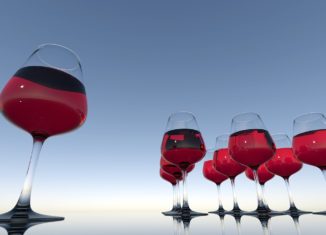
Almost every red wine, and a handful of white wines need aerating. Simply put, after being immersed in bottles for so long, these wines need to be able to ‘breathe’ before consumption. Right before drinking, exposing them to air or oxygen allows the wine to release its complex aromas and open up its flavors and tastes before drinking.
But wine aeration is not simply uncorking the bottle and letting it sit. A wine bottle’s neck is too narrow and doesn’t provide sufficient exposure to the wine; this is where decanters have a role to play.
A typical decanter is quite an unconventional-looking glass bottle with a large bottom. An entire bottle of wine may get poured into it to allow it to aerate/breathe before enjoying. Though technically, decanting means the process of using this decanting, but often decanting is also used as a synonym for aerating.
Hence decanting in decanters is an elegant and easy way of wine aeration. However, if you don’t have a wine decanter handy, a simple way to adequately aerate wines is to pour them into an aerating wine glass and let it sit for about 20 minutes.
Whichever aeration technique is adopted, it is vital to know which wines need to breathe to bring out the best of flavor, and wines can skip the cumbersome processes and go straight down the goblet. Wines, based on aeration, get divided into five sub-categories:
- Wine aeration category 1:
This group includes young and tannic red wines; young wines have the maximum tannins. Red wines, primarily known for their peaking tannic profiles, are served well with some aeration. Since aeration allows the tannins to soften a bit, mellowing the complex and intense edges. Thus making the drinking experience more pleasant and not letting the tannic punch overpower the general taste of the drink.
Here, wine aeration tries to supplement the wine’s natural aging. Being bottled up in the cellar for years or an hour’s available oxygen exposure, both processes help to break down the harsh tannins. However, actual wine aging cannot be compensated for because, over time, many chemical reactions take place, which cannot be replicated by decanting alone. But when bold red wine gets paired with impatience, aerating allows one to taste the core of its flavors and aroma without the risk and hassle of wine storage.
Rule of thumb: The younger a tannic wine, the longer it must be allowed to breathe. A robust and young red wine typically needs an hour to soften the tannins.
- Wine aeration category 2:
This group includes aged red wines. It is not uncommon to age red wines. But after a point (generally 8 to 10 years of aging), various elements of the wine, chemicals, and tannins, bond together, solidify and settle as sediment at the base of the wine bottle. When decanting these aged wines, it is wise to segregate this sediment as it adds bitterness to the taste of the wine. When pouring into a decanter, pour carefully so that settled sediment is not disturbed. Pour slowly and stop to ensure the residue is left behind and does not find its way into the decanter. If some particles go into the decanter, they will probably be too little to make much of a difference to the drinking experience.
Rule of thumb: Aged wines, unlike young wines, need only a little time in the decanter, lest their delicious and mellow flavors might fade in the process of over oxidation. About 10 to 15 minutes is commonly sufficient.
- Wine aeration category 3:
Group 3 consists of select white wines. Although quite untypical, few white wines also benefit from decantation. Red wines are generally favored for high tannins and aging benefits; some white wines also portray similar characteristics to their red counterparts. They display red wine traits like heavy mouth feels and are full-bodied and dry (unlike the typical white wine).
These include burgundies and white Bordeaux wines. They probably need some aeration if they seem a little off in aroma or taste right out of the bottle.
Rule of thumb: Wines of this group need about half an hour in the decanter. You must know that white wines must not be allowed to get too warm in the process of aerating. A little patience will leave you with an enjoyable drinking experience.
- Wine aeration category 4:
It includes vintage “Porto” or ports. These are distinct from regular ports. Though both kinds are delicious, “Porto” is aged about 20 years. After being cooped up for two decades in a wine bottle, it reacts very well to air. Allowing it to breathe in oxygen helps expose its flavors quicker but also aids in avoiding the sediment build-up at the bottom of the bottle – as discussed earlier with aged red wines.
Rule of thumb: Similar to regular aged red wines, allows a Porto to stand upright before decanting. It is advisable to decant it for up to 4 hours to enjoy the best flavors.
- Wine aeration category 5:
Several wines defy the rules and don’t need traditional decantation. Some light-bodied and naturally less tannic wines are produced for immediate consumption and do not require any aeration. These wines do not require aerating at all.
To make the most of what each wine has to offer in taste, you need good wine knowledge and simple skill to aerate the good wines and know which ones to choose. Gaining knowledge is the easiest way to become a wine lover from a wine drinker.
Get a glass that can bring the authentic taste of your wine!
